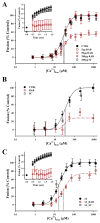Unbiased Thiol-Labeling and Top-Down Proteomic Analyses Implicate Multiple Proteins in the Late Steps of Regulated Secretion
- PMID: 31569819
- PMCID: PMC6958363
- DOI: 10.3390/proteomes7040034
Unbiased Thiol-Labeling and Top-Down Proteomic Analyses Implicate Multiple Proteins in the Late Steps of Regulated Secretion
Abstract
Regulated exocytosis enables temporal and spatial control over the secretion of biologically active compounds; however, the mechanism by which Ca2+ modulates different stages of exocytosis is still poorly understood. For an unbiased, top-down proteomic approach, select thiol- reactive reagents were used to investigate this process in release-ready native secretory vesicles. We previously characterized a biphasic effect of these reagents on Ca2+-triggered exocytosis: low doses potentiated Ca2+ sensitivity, whereas high doses inhibited Ca2+ sensitivity and extent of vesicle fusion. Capitalizing on this novel potentiating effect, we have now identified fluorescent thiol- reactive reagents producing the same effects: Lucifer yellow iodoacetamide, monobromobimane, and dibromobimane. Top-down proteomic analyses of fluorescently labeled proteins from total and cholesterol-enriched vesicle membrane fractions using two-dimensional gel electrophoresis coupled with mass spectrometry identified several candidate targets, some of which have been previously linked to the late steps of regulated exocytosis and some of which are novel. Initial validation studies indicate that Rab proteins are involved in the modulation of Ca2+ sensitivity, and thus the efficiency of membrane fusion, which may, in part, be linked to their previously identified upstream roles in vesicle docking.
Keywords: 2-dimensional gel electrophoresis; Rab GTPase; calcium; exocytosis; secretory vesicle; thiol-reactivity.
Conflict of interest statement
The authors declare no conflict of interest.
Figures






Similar articles
-
Dissecting the mechanism of Ca2+-triggered membrane fusion: probing protein function using thiol reactivity.Clin Exp Pharmacol Physiol. 2010 Feb;37(2):208-17. doi: 10.1111/j.1440-1681.2009.05278.x. Epub 2009 Aug 4. Clin Exp Pharmacol Physiol. 2010. PMID: 19671061
-
Identifying critical components of native Ca2+-triggered membrane fusion. Integrating studies of proteins and lipids.Ann N Y Acad Sci. 2009 Jan;1152:121-34. doi: 10.1111/j.1749-6632.2008.03993.x. Ann N Y Acad Sci. 2009. PMID: 19161383
-
Application of High-Throughput Assays to Examine Phospho-Modulation of the Late Steps of Regulated Exocytosis.High Throughput. 2017 Nov 13;6(4):17. doi: 10.3390/ht6040017. High Throughput. 2017. PMID: 29479054 Free PMC article.
-
Calcium sensors in regulated exocytosis.Cell Calcium. 1998 Nov-Dec;24(5-6):367-76. doi: 10.1016/s0143-4160(98)90060-4. Cell Calcium. 1998. PMID: 10091006 Review.
-
How the stimulus defines the dynamics of vesicle pool recruitment, fusion mode, and vesicle recycling in neuroendocrine cells.J Neurochem. 2016 Jun;137(6):867-79. doi: 10.1111/jnc.13565. Epub 2016 May 2. J Neurochem. 2016. PMID: 26849771 Review.
Cited by
-
Interactions between Muscle and Bone-Where Physics Meets Biology.Biomolecules. 2020 Mar 10;10(3):432. doi: 10.3390/biom10030432. Biomolecules. 2020. PMID: 32164381 Free PMC article. Review.
-
Optimized Proteome Reduction for Integrative Top-Down Proteomics.Proteomes. 2023 Mar 6;11(1):10. doi: 10.3390/proteomes11010010. Proteomes. 2023. PMID: 36976889 Free PMC article.
-
GLOBAL AND TARGETED PROFILING OF GTP-BINDING PROTEINS IN BIOLOGICAL SAMPLES BY MASS SPECTROMETRY.Mass Spectrom Rev. 2021 May;40(3):215-235. doi: 10.1002/mas.21637. Epub 2020 Jun 10. Mass Spectrom Rev. 2021. PMID: 32519381 Free PMC article. Review.
-
Proteomics-The State of the Field: The Definition and Analysis of Proteomes Should Be Based in Reality, Not Convenience.Proteomes. 2024 Apr 19;12(2):14. doi: 10.3390/proteomes12020014. Proteomes. 2024. PMID: 38651373 Free PMC article.
-
Special Issue "Top-down Proteomics: In Memory of Dr Alfred Yergey". Alfred Linwood Yergey, III, 17 September 1941-27 May 2018.Proteomes. 2020 Jan 15;8(1):1. doi: 10.3390/proteomes8010001. Proteomes. 2020. PMID: 31952104 Free PMC article.
References
LinkOut - more resources
Full Text Sources
Miscellaneous

